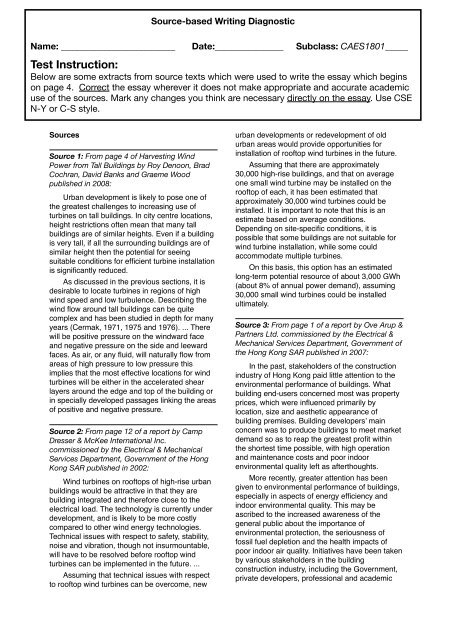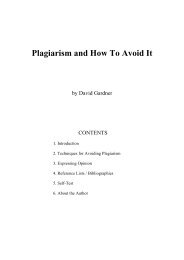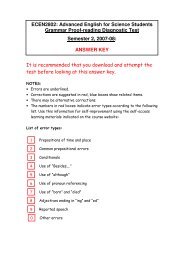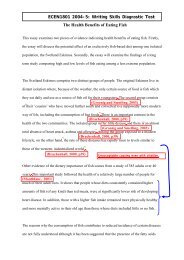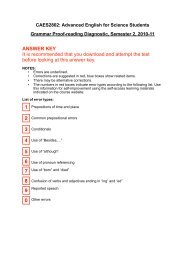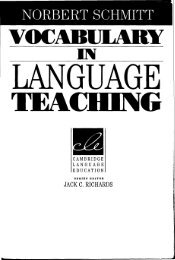Test!Instruction:
Test!Instruction:
Test!Instruction:
Create successful ePaper yourself
Turn your PDF publications into a flip-book with our unique Google optimized e-Paper software.
Name:___________________________institutions and individual practitioners, topromote and enhance environmentalperformance of buildings.Source!4:!From page 469 of Sustainable Energy,a chapter by Gordon Ting Leung Ng in the bookSustainable Development in Hong Kong editedby Terri Mottershead published in 2004:The overall growth in end use energydemand has resulted in an increase in primaryenergy consumption. In Hong Kong, the mainprimary energy consumed was coal, theconsumption of which increased from 9,300billion tonnes in 1988 to the peak of 12,000tonnes in 1993, mostly for electricity generation.Coal consumption dropped to around 9,000 billiontonnes after 1993 with the Daya Bay NuclearPower Plant coming into operation and droppedfurther to around 6,000 tonnes after 1996 with theuse of natural gas in generating some of theelectricity. This contributed to a significantreduction in air emissions from electricitygeneration after 1994....The Hong Kong government’s energy policywas formulated by the Economic Services Bureau(ESB) and has two broad objectives (ESB, 1998):1. to ensure that the energy needs of thecommunity are met reliably, efficiently,safely and at reasonable prices; and2. to promote the efficient use andconservation of energy and theminimization of the environmental impactof energy production and use.Source!5:!From page 5 of Green Buildings Payby Brian Edwards published in 2003:The main benefits of green design to adeveloper are financial: taking a long-term view,the running costs will pay several times over thegreater initial investment. In many cases thedistinctive form of a building designed tosustainable principles will set the building apartfor neighbors and provide a cachet that attractstenants. Just as some cars and washingmachines are sold as being green (or greenerthan competitors) so, too, green buildings willappeal to a section of the property market. Tohave comprehensive application, green buildingsneed to show they pay less in direct ways.There are three ways in which sustainabledesign benefits both the developers and theirtenants and has an indirect bearing balancesheets. Green buildings:! -are healthier to use;! -have psychological advantage;! -enhance company imageSource!6:!From The Folly of Building-IntegratedWind an article by Alex Wilson in EnvironmentalBuilding News published in 2009 (no pagenumbers):Wind speed typically increases with height,as it is less affected by trees and surroundingtopography. Putting wind turbines on top ofbuildings—especially tall buildings—should allowthem to take advantage of height without anexpensive, full-size tower.In some cases, building geometry canenhance wind turbine performance. Severalmanufacturers of building-integrated windturbines are taking advantage of the increasedwind velocities at building parapets—where thewind rises up the façade of a large building andcurls over the edge. Some architects aredesigning wind scoops right into the structures ofbuildings or situating building towers to funnelwind into turbines.Most of our electricity is used in buildings,and generating the electricity on site reduces theneed for transmission. This in turn reducestransmission losses as well as the materialsneeded for wiring and poles. In addition to thispractical benefit, wind turbines spinning on abuilding provide a visible testament to a buildingowner’s commitment to the environment. Whilebuilding-integrated photovoltaics (PV) can make asimilar statement, the modules just sit there; wedon’t see them generating electricity....Unfortunately, building-integrated wind oftendoesn’t live up to its promise. The turbines mustovercome several challenges to meetperformance expectations and be cost effective.The best wind-turbine performance happenswith strong laminar wind, in which all of the airflows in a single direction. But on top of even verytall buildings, wind flow is highly turbulent.CAES1801: Source-based Writing Diagnostic! page 2 of 6
Name:___________________________Student essay:Building-Integrated Wind Energy in Hong KongHong Kong, like every other developed region in the world isincreasingly facing pressure to exploit clean and renewable sources ofenergy, however, we face some challenging limitations, primarily the lack ofland to develop large-scale solar or wind power plants. This does nothowever mean that it is not possible for a significant portion of ourelectrical energy to be derived from renewable sources of energy,particularly wind. Scientists have begun to recognize that there are someadvantages, and challenges, to installing wind turbines directly on tallbuildings. The purpose of this essay is to explain building-integrated windand discuss how it might benefit Hong Kong in the future. The essay beginsby laying out some of the advantages of building integrated wind and thendiscusses two major technical hurdles that must be overcome if we are toexploit this technology.In order for Hong Kong to become less dependent on other countries forenergy and also help improve our living environment we must find sources ofrenewable energy. The use of coal as a primary energy source contributes toair pollution and past efforts to reduce the amount of energy generated bycoal have produced tangible benefits in the form of lower levels of airpollution. Although solar energy can make a useful contribution to ourCAES1801: Source-based Writing Diagnostic! page 3 of 6
Name:___________________________supply of electricity, the small amount of rooftop space in Hong Kong meansthat we must find even more sources of clean energy. These small rooftopsare, however, high in the air, where the wind is typically faster. Windturbines situated on rooftops of high-rise buildings would be attractivebecause they are building integrated and therefore close to the electricalload. The technology is currently being developed, and may be more costlycompared to other wind technologies. Technical issues with respect tostability, safety, vibration and noise, though not insurmountable, will needto be resolved before rooftop wind turbines can be implemented in the future.Once these technical hurdles have been overcome the potential amount ofenergy that could be generated from building-integrated wind turbines is verysignificant, about 8% of annual power demand of Hong Kong could be met withthis technology. Generating this electricity would not release any carboninto the atmosphere and since it is being generated at the point where it isbeing used, there would not be energy losses due to transmission.One of the technical challenges associated with building integratedwind is that if surrounding buildings are of similar height then thepotential for seeing suitable conditions for efficient turbine installationis significantly reduced. Because this is an issue that deals primarily withthe planning of buildings, the Hong Kong Government needs to back-up thestated objective of promoting energy efficiency and conservation byCAES1801: Source-based Writing Diagnostic! page 4 of 6
Name:___________________________controlling the height of new developments so as to create a terraced effect;this would allow the higher floors of each building to have better views,more fresh air for ventilation and greater access to wind energy.Another technical hurdle that exists with wind energy is that wind flowaround tall buildings can be quite complex and this means that it is quiteturbulent, although wind generation is most effective with a strong laminarwind. However this challenge can be overcome if the property developers inHong Kong can begin to better consider the environmental impact of buildings.In the past the developers’ main concern was to produce buildings to meetmarket demand so as to reap the greatest profit within the shortest timepossible, with high operation and maintenance costs and poor indoorenvironmental quality left as afterthoughts. If however, developers begin tounderstand that the running costs will pay several times over the greaterinitial investment then they will begin to follow what some architects aredoing and design features directly into the building that can channel windinto the turbines. These design features can direct the wind into speciallydeveloped passages linking the areas of positive and negative pressure. Notonly will these buildings be less expensive to operate in the long term theywill also be healthier, promote the images of companies occupying them andfoster the psychological well-being of the people living and working withinCAES1801: Source-based Writing Diagnostic! page 5 of 6
Name:___________________________them. In the end, these green buildings will be a win-win situation for bothdevelopers and the people of Hong Kong.The people of Hong Kong are increasingly aware of the importance ofenvironmental protection, the seriousness of fossil fuel depletion and thehealth impacts of poor indoor air quality and the Government as well as thedevelopers will need to act in response to this awareness. Buildingintegrated wind power can play an important role in making Hong Kong ahealthier and more environmentally friendly city and this will help to ensureour continued prosperity. By working together to meet the needs of thepublic, the Government and developers can make this happen.References[CDM] Camp Dresser & McKee International Inc. 2002 Dec. Study on thePotential Applications of Renewable Energy in Hong Kong: Stage 1 StudyExecutive Summary. Hong Kong: Electrical and Mechanical Services (HK).Agreement No.: CE36/2000Denoon R. Cochran B. Banks D. and Wood G. 2008 March 3-5. Harvesting WindPower from Tall Buildings. [Internet] Proceeds from CTBUH 8th WorldCongress "Tall and Green: Typology for a Sustainable Urban Future".[Cited 2010 Nov 2] Available from: http://www.ctbuh.org/Portals/0/Repository/T8_DenoonWood.357b6d8b-96e3-4988-b1d6-240cbafe12e3.pdfEdwards B. 2003. Green Buildings Pay. London: Spon Press.[ESB] Economic Services Bureau (HK). 1998. Energy policy from anenvironmental perspective: ACE Paper 48/98. Economic Services Bureau (HK).Hong Kong.Ng GTL. 2004. Sustainable Energy. In Mottershead T, editor. SustainableDevelopment in Hong Kong. Hong Kong: HKU Press.[OAP] Ove Arup & Partners Hong Kong Ltd. 2007 Mar. Consultancy Study on LifeCycle Energy Assessment of Building Construction: An Introduction to LifeCycle Energy Assessment (LCEA) of Building Developments. Hong Kong:Electrical and Mechanical Services Department (HK). Agreement No.:CAO L013Wilson A. 2009 May. The folly of building-integrated wind. [Internet]Environmental Building News. 18(5) [Cited on 2010 Nov 15] Available from:http://www.buildinggreen.com/auth/article.cfm/2009/4/29/The-Folly-of-Building-Integrated-Wind/CAES1801: Source-based Writing Diagnostic! page 6 of 6


